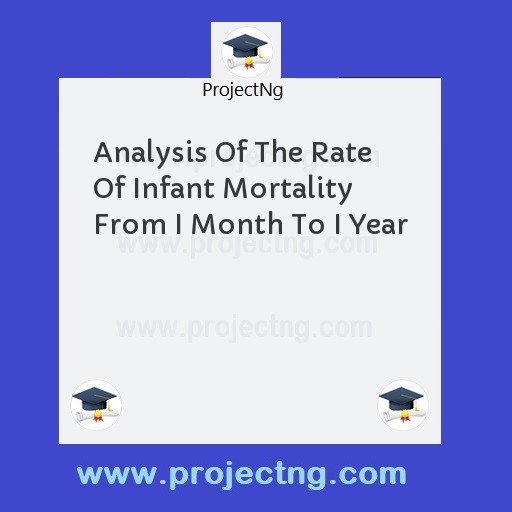Analysis Of The Rate Of Infant Mortality From I Month To I Year
Statistic Project Topics
Get the Complete Project Materials Now! »
ANALYSIS OF THE RATE OF INFANT MORTALITY FROM I MONTH TO I YEAR
ABSTRACT
The rate of death of our children attracts concern from every Nigerian.
It is clear that the only way to wipe out a race is to cut its means of future reproduction which is the children and this children are believed to be our future presidents, governors etc and the ensure older generation of a better tomorrow.
Infant morality have a considerable significance on demography.
The level of death rate in early life has been described as a crucial test of the health service and special progress of a country.
The young child’s life is wholly dependent on the care of mothers. It is base on this that the government through the ministry of health fights to ensure that all the preventable childhood disease that leads to infant deaths the reduced to most minimal level. This gave way to the introduction of Expanded programme on immunization (EPI) and ORAL Dehydration Therapy (ORT). These programmes are aimed at teaching parents on how to make salt, sugar, water as oral drip to cure diarrhea and to immunize poliomyelitis, small pox, chicken pox, whooping cough and tuberculosis.
Ever since the introduction of these programmes, great lots have been achieved by reducing the number of infants death. This instigated my writing this project.
With the data I collected from park-lane general hospital, Enugu on the number of infants death and sex distribution.
TABLE OF CONTENTS
Cover Page
Title Page
Approval Page
Dedication
Acknowledgement
Abstract
Table Of Contents
CHAPTER ONE: INTRODUCTION
1.1 Aims and objectives
1.2 Limitations of the study
1.3 Definition of terms
CHAPTER TWO: LITERATURE REVIEW
CHAPTER THREE: RESEARCH METHODOLOGY
3.1 Method of data collections/source
3.2 Problems encountered during the study
3.3 Methods of analysis
3.4 Estimation of population ratio
3.5 Demographic data
3.6 Chi-square
3.7 The wilcoxon rank-sum test
3.8 Data on births
3.9 Data on death
CHAPTER FOUR: DATA ANALYSIS
4.1 Estimation of population ratio
4.2 Demographic data analysis
4.3 Chi-square analysis
4.4 Wilcoxon rank-sum test analysis
CHAPTER FIVE: SUMMARY OF FINDINGS,
CONCLUSIONS AND
RECOMMENDATION
5.1 findings and conclusion
5.2 Conclusion
5.3 Recommendation
Bibliography
CHAPTER ONE
1.0 INTRODUCTION
Infant mortality is mostly caused by diseases and these diseases are due to the prevalence of parasite hosts in certain areas. It is believed that year, thousands of children are born in this country and thousands of these children die from diseases such as diphtheria, whooping cough, tetanus, poliomyelitis, measles and childhood tuberculosis.
This is stated in a pamphlet on Expanded Programme on Immunization (EPI) published by the Federal Epidemiological unit, Federal Ministry of Health, Lagos, 1981.
Children’s development and survival are influenced by a number of factors which include environmental sanitation, most of all nutrition and parents lack of awareness some children are malnourished due to the fact that their parents do not know what constitutes a balanced diet for. They lack the knowledge of what helps the children to grow normally and build up strong immunity against such diseases that emanate from under – nourished diet. Some parents are illiterate and ignorant, that is why in some remote areas of the country children die out of carelessness and parent ignorance.
Ignorance, in the sense that some parents do not know or observe the programme introduced by the ministry of Health to ward – off those six killer diseases which is Expanded Programme on Immunization (EPI), presently, the government of Nigeria has carried out a national expanded programme on immunization (EPI) to control these six childhood diseases throughout the federation.
Although, Nigeria has been declared small pox free surveillance against the disease is still being maintained. Government should be commended on their efforts to create awareness on the side of the parent and their effort to ward off these diseases, thereby reducing the infant deaths in the country.
More can be done also by educating the parents o how to maintain good environmental hygiene ad nutritional standard of their diet so as to rear healthy children.
Actually, the rate of infant mortality motivated me to carry out a research on this project topic and also suggest ways which can reduce the rate of infant mortality.
1.1 AIMS AND OBEJCTIVES
The aims and objectives of this project are as following
1. To determine the ratio of males to females death, among infants less than 1 year.
2. To determine whether infant mortality is greater tan the standard range for infant, mortality which is (10-55) deaths per every 1000.
3. To determine if mortality is independent of sex of a child.
4. To determine if the mean mortality for male and female infants are the same.
5. To suggest possible preventive measures to reduce the number of infant deaths that occur.
Be the First to Share On Social

Enjoying our content?
Don't miss out on new videos! Subscribe to our YouTube channel for more awesome content.
Subscribe Now!













